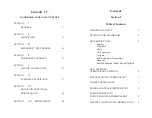
36
37
The most suitable way of laying out a wing is in an arc, which enables
the paraglider to fill up evenly, starting from the centre. It is essential
to assure that every row of suspension lines is free of tangles and
knots and that no line goes around the wing tip. In fact, any defect in
the sail during the phase of take-off can have unpredictable effects
on the trajectory.
The direction of the take-off, from the wing centre should be into
the wind starting with taut lines and no jerk, leaning forwards for a
progressive pull.
The pilot will limit the movements of his hands to simply accom-
panying the rising wing with front risers applying light traction. Too
strong a traction can partly close the leading edge intakes.
In moderate winds (from 10 mph), in order to avoid a brutal take-off,
it is recommended to use a back to wind technique, by going to the
canopy during the raise to slow down the take off..
Taking off for a pilot unfamiliar with reversed inflation techniques
should be forbidden in wind speeds over 20 km/h.
INFLATION AND TAKE-OFF
RAPID DESCENT TECHNIQUES
360° :
In a 360° spiral, a sink rate of more than 10 m/s / 30 ft/s is
attained. This manoeuvre can disorientate the pilot (loss of reference
point and strong acceleration).
One should learn this technique progressively. In particular one
should avoid the symmetrical mid braking position for coming out of
the spiral. This is best obtained by raising both hands progressively.
EARS:
The PIPER has an important reflex profile bringing a high
amount of stiffness to the leading edge. That ridgidity makes the
PIPER very stable but also the “Ears” configuration physically harder
to implement.
Procedure:
Trims closed, use the control loop straps, grasp the “A”
riser at link level and bring it down about 40 cm with a strong pull;
maintain and hold that position for the time of the maneuver.
“B-STALL” DESCENT :
A “B-stall” descent” is a classic maneuver.
Nevertheless it must be used with discernment. The traction on the
“B” risers must not exceed 35 cm so as not to act also on the “A”
risers at the same time. The exit is generally spontaneous, and dyna-
mic at times, all the more so if the sink rate reached is high and the
risers are let go quickly. If nevertheless, a parachutal phase was to
occur (wet or worn wing, and very slow riser release, for example), a
slight turn using the toggles would likely help toward a manageable
exit.
For these 3 manoeuvres and for all other phases of flight, we strongly
recommend keeping the toggles in the hands which enables an ins-
tant return to conventional piloting. The emergency manoeuvres
should only be used when necessary. After a while they weaken the
lines, the ribs and the attachment points.











































